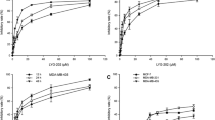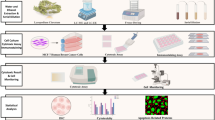Abstract
Medicinal plant extracts have been widely used for cancer treatment. Gaillardin is a natural sesquiterpene lactone that has recently been reported to have anticancer properties. The ability to induce apoptosis is an important property of a candidate anticancer drug, which discriminates between anticancer drugs and toxic compounds. The current study was therefore carried out to address the issue if Gaillardin is able to induce apoptosis in the breast cancer cell lines MCF-7 and MDA-MB-468 and to determine the underlying mechanism of its anticancer effects. Apoptosis induction by Gaillardin treatment was confirmed by annexin V–FITC/PI staining, and caspase-3,-6, and-9 activation. Using Western blot analysis, we found that Gaillardin upregulated the pro-apoptotic protein Bax and p53 and downregulated the anti-apoptotic protein Bcl-2. Moreover, the apoptotic effect of Gaillardin was also related to ROS production and loss of mitochondrial membrane potential (ΔΨm). Taken together, these results demonstrate that Gaillardin can inhibit proliferation of breast cancer cells via inducing mitochondrial apoptotic pathway and therefore, might be a promising molecule in cancer chemoprevention or chemotherapy.







Similar content being viewed by others
Abbreviations
- ΔΨm:
-
Mitochondrial membrane potential
- MTT:
-
3-(4,5-dimethyl-2-thiazolyl)-2,5-diphenyl-2H-tetrazolium bromide
- SLs:
-
Sesquiterpene lactones
- ROS:
-
Reactive oxygen species
References
Aghaei M, Karami‐Tehrani F, Panjehpour M, Salami S, Fallahian F. Adenosine induces cell‐cycle arrest and apoptosis in androgen‐dependent and‐independent prostate cancer cell lines, LNcap‐FGC‐10, DU‐145, and PC3. Prostate. 2012;72:361–75.
Brunelle JK, Letai A. Control of mitochondrial apoptosis by the Bcl-2 family. J Cell Sci. 2009;13:437–41.
Chadwick M, Trewin H, Gawthrop F, Wagstaff C. Sesquiterpenoids lactones: benefits to plants and people. Int J Mol Sci. 2013;14:12780–805.
Cory S, Huang DC, Adams JM. The Bcl-2 family: roles in cell survival and oncogenesis. Oncogene. 2003;22:8590–607.
Cui H, Schroering A, Ding HF. P53 mediates DNA damaging drug-induced apoptosis through a caspase-9-dependent pathway in SH-SY5Y neuroblastoma cells. Mol Cancer Ther. 2002;13:679–86.
Debatin KM. Activation of apoptosis pathways by anticancer treatment. Toxicol Lett. 2000;14:41–8.
Fallahian F, Karami-Tehrani F, Salami S, Aghaei M. Cyclic GMP induced apoptosis via protein kinase G in oestrogen receptor-positive and -negative breast cancer cell lines. FEBS J. 2011;278:3360–9.
Fallahian F, Karami-Tehrani F, Salami S. Induction of apoptosis by type Iβ protein kinase G in the human breast cancer cell lines MCF-7 and MDA-MB-468. Cell Biochem Funct. 2012;30:183–90.
Ghantous A, Gali-Muhtasib H, Vuorela H, Saliba NA, Darwiche N. What made sesquiterpene lactones reach cancer clinical trials? Drug Discov Today. 2010;15:668–78.
Ghate NB, Hazra B, Sarkar R, Mandal N. Heartwood extract of Acacia catechu induces apoptosis in human breast carcinoma by altering bax/bcl-2 ratio. Pharmacogn Mag. 2014;10:27–33.
Gonzalez Romero MA, Villaescusa Castillo L, Diaz Lanza AM, Bartolome Esteban C, Fernandez Matellano L. Phytochemistry and pharmacological studies of Inula montana L. Recent Res Dev Phytochem. 2001;5:255–68.
Green DR, Kroemer G. The pathophysiology of mitochondrial cell death. Science. 2004;305:626–9.
Green DR, Reed JC. Mitochondria and apoptosis. Science. 1998;281:1309–12.
Hamzeloo-Moghadam M, Naghibi F, Atoofi A, Asgharian Rezaie M, Irani M. Cytotoxic activity and apoptosis induction by Gaillardin. Z Naturforsch. 2013;68:108–12.
Hamzeloo-Moghadam M, Aghaei M, Fallahian F, Jafari SM, Dolati M, Abdolmohammadi MH, et al. Britannin, a sesquiterpene lactone, inhibits proliferation and induces apoptosis through the mitochondrial signaling pathway in human breast cancer cells. Tumor Biol. 2015;36:1191–8.
Hickman J. Apoptosis induced by anticancer drugs. Cancer Metastasis Rev. 1992;14:121–39.
Jänicke RU, Sprengart ML, Wati MR, Porter AG. Caspase-3 is required for DNA fragmentation and morphological changes associated with apoptosis. J Biol Chem. 1998;273:9357–60.
Juin P, Hunt A, Littlewood T, Griffiths B, Swigart BL. c-Myc functionally cooperates with Bax to induce apoptosis. Mol Cell Biol. 2002;13:6158–69.
Korsmeyer SJ, Wei MC, Saito M, Weiler S, Oh KJ, Schlesinger PH. Pro-apoptotic cascade activates BID, which oligomerizes BAK or BAX into pores that result in the release of cytochrome c. Cell Death Differ. 2000;7:1166–73.
Kreuger MR, Grootjans S, Biavatti MW, Vandenabeele P, D'Herde K. Sesquiterpene lactones as drugs with multiple targets in cancer treatment: focus on parthenolide. Anti-Cancer Drugs. 2012;23:883–96.
Merfort I. Perspectives on sesquiterpene lactones in inflammation and cancer. Curr Drug Targets. 2011;12:1560–73.
Mosaddegh M, Moghadam MH, Ghafari S, Naghibi F, Ostad SN, Read RW. Sesquiterpene lactones from Inula oculus-christi. Nat Prod Commun. 2010;5:511–4.
Nechushtan A, Smith CL, Lamensdorf I, Yoon SH, Youle R. Bax and Bak coalesce into novel mitochondria-associated clusters during apoptosis. J Cell Biol. 2001;153:1265–76.
Schmidt TJ. Helenanolide-type sesquiterpene lactones-III. Rates and stereochemistry in the reaction of helenalin and related helenanolides with sulfhydryl containing biomolecules. Bioorg Med Chem. 1997;5:645–53.
Schuler M, Green DR. Mechanisms of p53-dependent apoptosis. Biochem Soc Trans. 2001;29:684–8.
Shirali S, Aghaei M, Shabani M, Fathi M, Sohrabi M. Adenosine induces cell cycle arrest and apoptosis via cyclind1/cdk4 and bcl-2/bax pathways in human ovarian cancer cell line ovcar-3. Tumour Biol. 2013;34:1085–95.
Simon HU, Haj-Yehia A, Levi-Schaffer F. Role of reactive oxygen species (ros) in apoptosis induction. Apoptosis. 2000;5:415–8.
Van Engeland M, Nieland LJ, Ramaekers FC, Schutte B, Reutelingsperger CP. Annexin V-affinity assay: a review on an apoptosis detection system based on phosphatidylserine exposure. Cytometry. 1998;31:1–9.
Wang X. The expanding role of mitochondria in apoptosis. Genes Dev. 2001;15:2922–33.
Watson WH, Cai J, Jones DP. Diet and apoptosis. Annu Rev Nutr. 2000;20:485–505.
Weitsman GE, Ravid A, Liberman UA, Koren R. Vitamin d enhances caspase-dependent and independent tnf-induced breast cancer cell death: the role of reactive oxygen species. Ann N Y Acad Sci. 2003;1010:437–40.
Zou H, Li Y, Liu X, Wang X. An APAF-1.cytochrome C multimeric complex is a functional apoptosome that activates procaspase-9. J Biol Chem. 1999;274:11549–56.
Acknowledgments
The authors would like to thank the financial support of Cellular and Molecular Research Center of Qom University of Medical Sciences and also Shahid Beheshti University of Medical Sciences.
Author information
Authors and Affiliations
Corresponding author
Ethics declarations
Conflict of interest
The authors declare that they have no competing interests.
Rights and permissions
About this article
Cite this article
Fallahian, F., Aghaei, M., Abdolmohammadi, M.H. et al. Molecular mechanism of apoptosis induction by Gaillardin, a sesquiterpene lactone, in breast cancer cell lines. Cell Biol Toxicol 31, 295–305 (2015). https://doi.org/10.1007/s10565-016-9312-6
Received:
Accepted:
Published:
Issue Date:
DOI: https://doi.org/10.1007/s10565-016-9312-6




